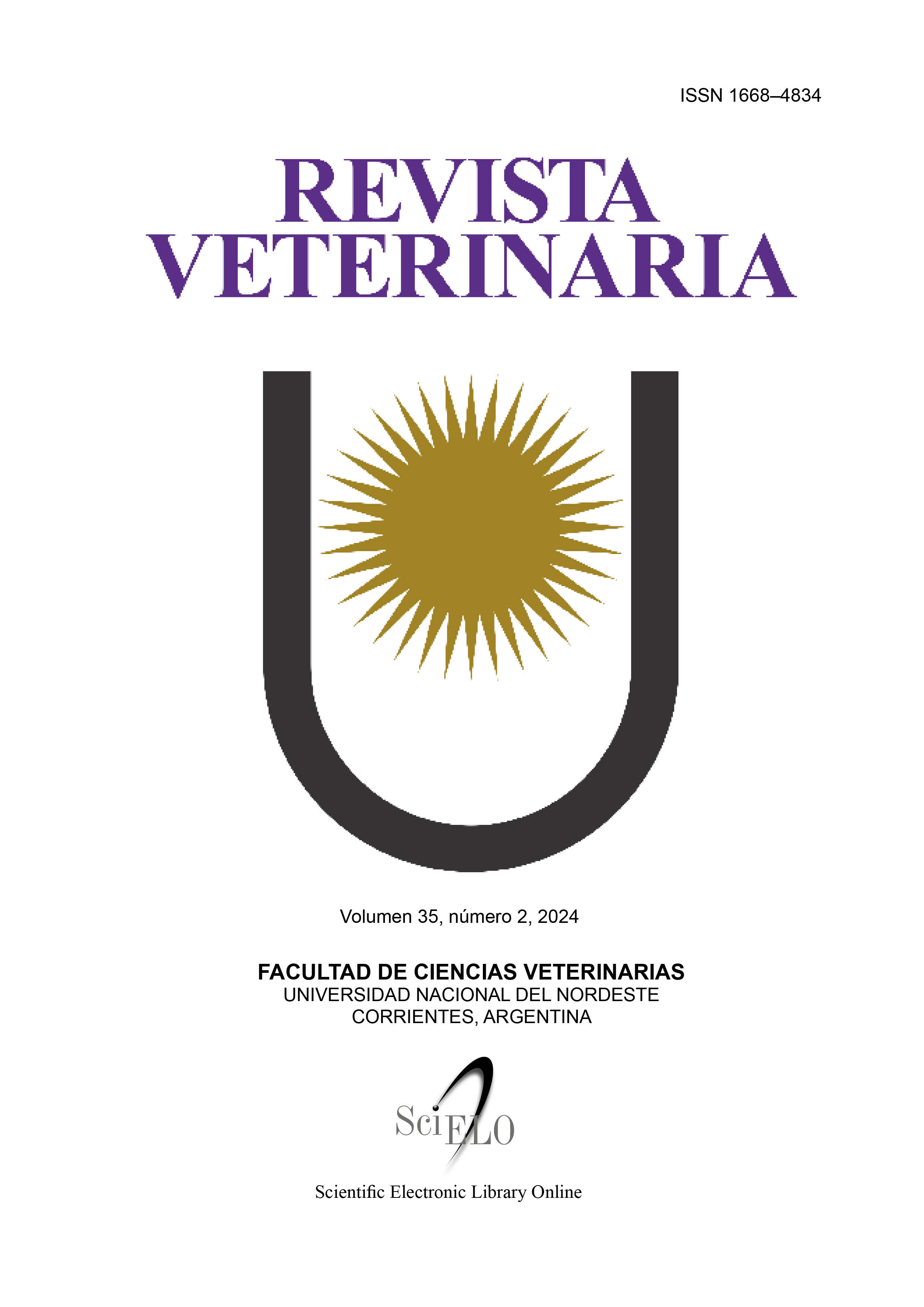Severe lymphoplasmacytic cholecystitis in a canine
a case report
DOI:
https://doi.org/10.30972/vet.3527861Keywords:
Gallbladder, Cholecystectomy, Domestic caninesAbstract
Cholecystitis in dogs is a condition that often does not receive the same attention as diseases of the hepatic parenchyma. Two probable routes of infection have been identified: the ascending route from the duodenum through the common bile duct and/or the hematogenous route through the enterohepatic circulation. This work describes a case of a 14-year-old female canine that presented an exacerbation of chronic cholecystitis, manifesting small intestine diarrhea and hyporexia of one month of progression. Empirical treatment was administered with ursodeoxycholic acid 15 mg kg-1 every 12 h, omeprazole 1 mg kg-1 every 12 h orally, and enrofloxacin 5 mg kg-1 every 24 h subcutaneously. This treatment initially resolved the clinical signs; however, the dog experienced a relapse. Cystocentesis of the gallbladder was performed and bile was cultured, obtaining a negative result. Due to the chronic changes observed in the gallbladder and cystic duct on ultrasound, it was elected to perform a cholecystectomy together with cystic duct ablation. Cytology of the gallbladder content showed purulent content, while the culture and antibiogram indicated the presence of Escherichia coli sensitive to cefovecin (8 mg kg-1 every 14 days, 2 doses). Surgical ablation was performed. Histopathology of the gallbladder and cystic duct revealed marked inflammation characterized by the presence of abundant lymphocytes, plasmacytes, and histiocytes. Due to inflammation in the remaining biliary tree, treatment with prednisolone was performed (initial dose of 1 mg kg-1 every 12 hours for 20 days, with gradual reduction of the dose by half at 20-day intervals until the treatment was completely discontinued, which resulted in the absence of digestive signs in the patient.
Downloads
References
Aguirre AL, Center SA, Randolph JF, Yeager AE, Keegan AM, Harvey HJ, Gallbladder disease in Shetland Sheepdogs: 38 cases (1995-2005). J Am Vet Med Assoc. 2007; 231(1): 79-88.
Aguirre AL. Diseases of the Gallbladder and Extrahepatic Biliary System Ettinger SJ, Edward CF (2010b) Diseases of the gallbladder and extrahepatic biliary system. In: Ettinger SJ, Feldman EC, eds. Textbook of Veterinary Internal Medicine. 7th ed. London: Elsevier Health Sciences: 1286-95.
Cueto-Ramos R, Hernández-Guedea M, Pérez-Rodríguez E, Reyna-Sepúlveda F, Muñoz-Maldonado G. Identificación de flora bacteriana en cultivos de bilis y pared de vesícula biliar de pacientes sometidos a colecistectomía laparoscópica en el Hospital Universitario «Dr. José Eleuterio González». Cir Cir. 2017; 85: 515-521.
Gilloteaux J, Miller D, Morrison RL. Intracellular liposomes and cholesterol deposits in chronic cholecystitis and biliary sludge. Ultrastruct Pathol. 2004; 28(3): 123-36.
Kakimoto T, Kanemoto H, Fukushima K, Ohno K, Tsujimoto H. Bile acid composition of gallbladder contents in dogs with gallbladder mucocele and biliary sludge. Amer J Vet Res. 2017; 78(2): 223-229.
Kaminski DL, Feinstein WK, Deshpande YG. The production of experimental cholecystitis by endotoxin. Prostaglandins. 1994; 47(3): 233-45.
Kaya M, Beştaş R, Bacalan F, Bacaksız F, Arslan EG, Kaplan MA. Microbial profile and antibiotic sensitivity pattern in bile cultures from endoscopic retrograde cholangiography patients. World J Gastroenterol. 2012; 18(27): 3585-9.
Lawrence YA, Ruaux CG, Nemanic S, Milovancev M. Characterization, treatment, and outcome of bacterial cholecystitis and bactibilia in dogs. J A. Vet Med Assoc. 2015; 246(9): 982-9.
Mitsui I, Ohtsuki S, Uchida K. Chronic Cholecystitis of Dogs: Clinicopathologic Features and Relationship with Liver. Animals (Basel). 2021; 11(11): 3324.
O’Neill EJ, Day MJ, Hall EJ, Holden DJ, Murphy KF, Barr FJ, Pearson GR. Bacterial cholangitis/cholangiohepatitis with or without concurrent cholecystitis in four dogs. J Small Anim Pract. 2006; 47(6): 325-35.
Park JW, Lee JK, Lee KT, Lee KH, Sung YK, Kang CI. How to interpret the bile culture results of patients with biliary tract infections. Clin Res Hepatol Gastroenterol. 2014; 38(3): 300-9
Peters LM, Glanemann B, Garden OA, Szladovits B. Cytological Findings of 140 Bile Samples from Dogs and Cats and Associated Clinical Pathological Data. J Vet Intern Med. 2016; 30(1): 123-31
Rossanese M, Williams P, Tomlinson A, Cinti F. Long-Term Outcome after Cholecystectomy without Common Bile Duct Catheterization and Flushing in Dogs. Animals. 2022; 12(16): 2112.
Tamborini A, Jahns H, McAllister H, Kent A, Harris B, Procoli F, Allenspach K, Hall EJ, Day MJ, Watson PJ, O’Neill EJ. Bacterial Cholangitis, Cholecystitis, or both in Dogs. J Vet Intern Med. 2016; 30(4): 1046-55.
Tsukagoshi T, Ohno K, Tsukamoto A, Fukushima K, Takahashi M, Nakashima K. Decreased gallbladder emptying in dogs with biliary sludge or gallbladder mucocele. Vet Radiol Ultrasound. 2012; 53(1):84-91.
Youn G, Waschak MJ, Kunkel KAR, Gerard PD. Outcome of elective cholecystectomy for the treatment of gallbladder disease in dogs. J Am Vet Med Assoc. 2018; 252(8): 970-975.
Yacoub WN, Petrosyan M, Sehgal I, Ma Y, Chandrasoma P, Mason RJ. Prediction of patients with acute cholecystitis requiring emergent cholecystectomy: a simple score. Gastroenterol Res Pract. 2010; ID 901739: 1-5.
Downloads
Published
How to Cite
Issue
Section
License

This work is licensed under a Creative Commons Attribution-NonCommercial 4.0 International License.
Revista Veterinaria (Rev. Vet.) maintains a commitment to the policies of Open Access to scientific information, as it considers that both scientific publications as well as research investigations funded by public resources should circulate freely without restrictions. Revista Veterinaria (Rev. Vet.) ratifies the Open Access model in which scientific publications are made freely available at no cost online.











.jpg)
.jpg)



